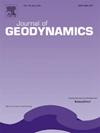厄瓜多尔西部纳斯卡板块俯冲几何形状的重力建模
IF 2.1
3区 地球科学
Q2 GEOCHEMISTRY & GEOPHYSICS
引用次数: 0
摘要
南美洲的厄瓜多尔和安第斯山脉极易受到危险事件的影响。尽管如此,厄瓜多尔俯冲板块的几何结构很少使用重力法进行研究,而重力法是一种用于了解地质结构的重要工具。本文利用欧洲增强地球重力模型和厄瓜多尔地震目录,建立了厄瓜多尔西部边界俯冲带的重力模型。利用地形校正、径向功率谱和欧拉反褶积来确定区域和残余重力分量以及重力源的深度,实施了一个工作流程。然后,海底形态结构被纳入模型构建,包括卡内基山脊、格里哈尔瓦断裂,以及其他分裂纳斯卡板块和法拉龙板块的因素。此外,还考虑了大陆板块现有的断裂,主要是分隔北安第斯地块和南美地块的多洛雷斯-瓜亚基尔体系断裂。这些模型是直接根据重力异常构建的,并使用震源进行校准。现有模型的均方根误差偏移较小,表明处理后的重力数据与模型的理论响应拟合较好。结果表明,沿纬度1°S和3°S的两个剖面,俯冲板块的几何变化是由洋壳的非均匀物理因素或法拉龙板块的先俯冲区引起的。本文章由计算机程序翻译,如有差异,请以英文原文为准。
Gravimetric modeling of the Nazca plate subduction geometry West of Ecuador
The Ecuador and Andean Cordillera in South America are highly vulnerable to hazard-ous events. Despite this, the geometry of the subduction plate in Ecuador has rarely been studied using the gravimetric method, a remarkable tool used to understand geological structures. In this study, a gravimetric model of the subduction zone at the western boundary of Ecuador was created using the European-enhanced gravity model of the Earth and the seismic catalog of Ecuador. A workflow was enforced using terrain corrections, the radial power spectrum, and Euler deconvolution to determine the regional and residual gravimetric components and depth of the gravimetric sources. Seafloor morphological structures were then incorporated into the model construction, including the Carnegie Ridge, fracture of Grijalva, and other elements that split the Nazca and Farallon Plates. Additionally, existing faults in the continental plate were considered, mainly the Dolores-Guayaquil system fault that separates the North Andean and South American Blocks. The models were directly constructed from gravimetric anomalies and calibrated using seismic hypocenters. The root mean square error of the current models exhibited a small offset, indicating a good fit between the processed gravimetric data and the theoretical response of the constructed model. The results were described for two sections along latitudes 1°S and 3°S, indicating that the geometric variations in the subduction plate were caused by heterogeneous physiographic elements in the oceanic crust or by a prior subduction area of the Farallon Plate.
求助全文
通过发布文献求助,成功后即可免费获取论文全文。
去求助
来源期刊

Journal of Geodynamics
地学-地球化学与地球物理
CiteScore
4.60
自引率
0.00%
发文量
21
审稿时长
6-12 weeks
期刊介绍:
The Journal of Geodynamics is an international and interdisciplinary forum for the publication of results and discussions of solid earth research in geodetic, geophysical, geological and geochemical geodynamics, with special emphasis on the large scale processes involved.
 求助内容:
求助内容: 应助结果提醒方式:
应助结果提醒方式:


